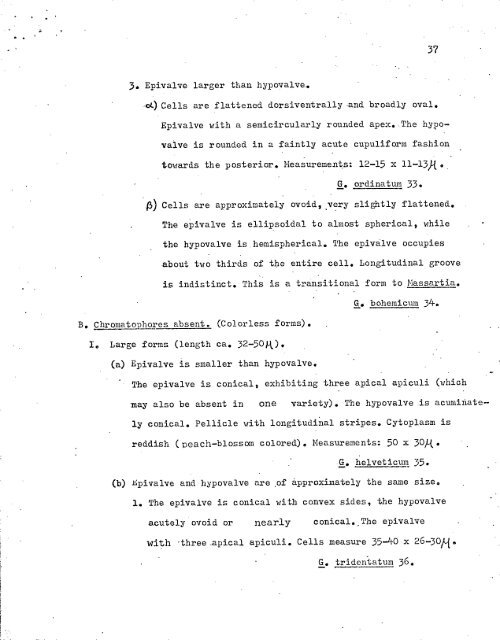Translation 2816
Translation 2816
Translation 2816
You also want an ePaper? Increase the reach of your titles
YUMPU automatically turns print PDFs into web optimized ePapers that Google loves.
37<br />
3. EpivAlve larger than hypoyalve,<br />
-4Cells are flattened dorsiventrally-and broadly oval.<br />
Epivalve with a semicircularly rounded apex. The hypovalve<br />
is rounded in a faintly acute cupuliform fashion<br />
towards the posterior. Measurements: 12-15 x 11-13X.<br />
G. ordinatum 33.<br />
p) Cells are approximately ovoid s.very slightly flattened.<br />
The epivalve is ellipsoidal to almost spherical, while<br />
the hypovalve is hemispherical. The epivalve occupies<br />
about two thirds of the entire cell. Longitudinal groove<br />
is indistinct. This is a transitional form to Massartia.<br />
G. bohemicum 34.<br />
B. Chromatophores absent. (Colorless forms).<br />
I. Large forms (length ca. 32-501.1).<br />
(a) Epivalve is smaller than hypovalve.<br />
The epivalve is conical, exhibiting three apical apiculi (which<br />
may also be absent in<br />
one variety). The hypovalve is acuminately<br />
conical. Pellicle with longitudinal stripes. Cytoplasm is<br />
reddish (peach-blossom colored). Measurements: 50 x 30k.<br />
G. helveticum 35.<br />
(b) 4ivalve and hypovalve are .of approximately the same size.<br />
1. The epivalve is conical with convex sides, the hypovalve<br />
acutely ovoid or nearly conical..The epivalve<br />
Idth three.apical apiculi. Cells measure 35-40 x 26-30M.<br />
• •<br />
G. triden'tatum 36.
















